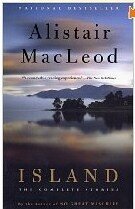The subject line is a quote from one of my all time favorite writers – Canadian Alistair MacLeod. The quote comes from MacLeod’s story “The Road to Rankin’s Point” which is in his book of short stories Island.
I have returned now, I think, almost as the diseased and polluted salmon, to swim for a brief time in the clear waters of my earlier stream. The returning salmon knows of no “cure” for the termination of his life.
The story is about a 26-year old man returning home to Cape Breton to try and convince his grandmother (on behalf of the rest of his family) to move to a nursing home. It turns out he has been diagnosed with terminal cancer but does not tell anyone, until he tells his grandmother near the end of the story (sorry to let that out, if you haven’t read the story) – and most likely part of the reference to diseased and polluted returning home.
The story has a lot to do with death – and yet also life. The cycle.
This ties in with a book I picked up at the library yesterday by Derrick Jensen and Aric McBay. The book has a bit of that “Chicken Little” element to it and can start to get a bit dour with too much reading.
 However, here is a great tidbit from the first chapter:
However, here is a great tidbit from the first chapter:
The health of the land begins with shit, with dead bodies, with body parts that fall to the ground. It begins with death, decomposition, decay. It begins with eating, metabolizing, excreting. That’s how it has always been, since the beginning of life. You feed me, I feed the soil, the soil feeds everyone, the soil feeds me, I feed you, you feed the soil, and so on.
Here’s another way to look at it: I eat you, the soil eats me, everyone eats the soil, you eat me, the soil eats you.
It’s all the same.
This reminded me of learning about mortuary poles when, as a kid, I visited old Haida villages in Gwaii Haanas National Park Reserve and Haida Heritage Site on the south end of Haida Gwaii of the coast of British Columbia. In essence a mortuary pole is a pole with a ‘box’ on the top. In the box certain individuals were placed when they died. Eventually the wood of the box would decompose and the bones would eventually fall to the ground to return to the earth – just as eventually the pole itself would too.
In Gwaii Haanas, there have been hot debates about the old totem poles. Common practice was to allow totem poles to fall and return to the earth where they came from. With creation of the “reserve park” the poles became great tourist attractions – for example the old village on Skung Gwaii is considered a United Nations World Heritage Site.
Should the poles return to the earth as they used to for thousands of years, or should they be propped up to secure a longer life above earth?
When salmon return to spawn – they die and feed everything – including, and especially, the soil. In years past, while doing stream surveys or other projects, I walked coastal streams in fall months. On Haida Gwaii, for example, fall months are chum salmon time in many streams. Chum can be quite large, say 15 to 20 pounds. When they spawn and then die after their short lives, their bodies line stream banks and gravel bars putrefying and feeding; rotting and nourishing; crawling and breaking-down.
Some times a great rain storm will come through and flood streams. Walking streams afterward, chum carcasses hang off stream-side branches and brush – flapping in the wind like national flags. Decayed carcasses wrap around logs like old gym socks. The skin, tougher than leather, can lay around on gravel bars for over a month – slipperier than the proverbial banana peel. Many carcasses flush out to estuaries feeding a myriad of critters there – crabs, clams, little fish, anemones, and so on.
Not only do salmon carcasses fertilize the forest like fish-meal in a garden – the shit of bears, eagles, and other critter feeds the soil, the trees, and everything else in the vicinity. Basic plant biology points out that plants need to get nitrogen (one of the building blocks for life) from different sources. There’s quite a bit of nitrogen in salmon carcasses – there’s even more nitrogen in bear pee after it eats salmon. Bear pee for plants is a good thing and a great source of nitrogen.
Salmon carcasses also feed the next generation of salmon. Various studies demonstrate that baby salmon hanging out in streams consume massive amounts of nutrients left by their parents decomposing bodies – either direct feeding on carcass remnants or eating insects that metamorphosized out of carcasses from the year previous. As high as 40-60% of stomach contents of some baby salmon are carcass derived. Continual declines in salmon carcasses in streams, means that baby salmon lose vital food sources.
This part of the story was lost when fisheries “management” over the last century suggested it was fine to take 50%-80% of salmon populations through various forms of fishing dictated by ensuring “Maximum Sustainable Yield”.
This stopped a lot of shitting in the forest. This stopped a lot of shit in the forest that was absorbed by everything in the vicinity.
Does a bear shit in the woods?
Sure does, especially when it’s eating a lot of salmon.
Here’s something to maybe make you smile – this is from he keeps a website of great little pieces of art – he does them on the back of business cards. This is how I feel when I read the latest fisheries management approaches proposed by government ministries, and government Ministers suggest that salmon declines might be from “localized” impacts…


